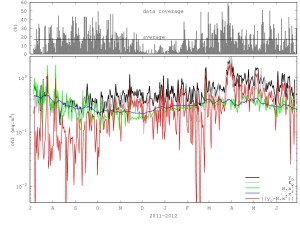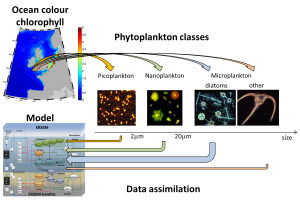Statistical-Dynamical Observation Operator for SST Data Assimilation
PI and organization: Andrea Storto (CMCC)
Co-Is: Gerasimos Korres (HCMR), Sam Pimentel (TWU), Nadia Pinardi (CMCC), Isabelle Mirouze (CMCC), Eric Jansen (CMCC), Francesca Macchia (CMCC).
Outcome
The SOSSTA project aims at formulating a dynamical-statistical observation operator for satellite SST observations that accounts for the diurnal variability of the skin SST layer. Indeed, most of current OGCMs assimilate only night-time measurements, or rely on gridded objective analyses, due to the difficulties in predicting the diurnal cycle of the skin SST layer. A dynamical-statistical operator for satellite SST data assimilation aware of the skin SST diurnal cycle has been formulated and implemented in two regional operational analysis systems (the MED-MFC and the POSEIDON system, covering the Mediterranean Sea and the Aegean Sea, respectively). In order to map the model profiles onto skin and subskin SST, required by data assimilation schemes, the operator uses canonical correlations (CCA) that are calculated from the dataset of multiple realizations of a 1D high-resolution vertical turbulent model (GOTM), forced by the ECMWF atmospheric analyses and initialized through the MED-MFC ocean reanalysis.
The operator proves able to transform model background temperature profiles to model equivalent skin SST upon knowledge of the local time and atmospheric conditions. The MED-MFC and POSEIDON regional analysis systems were extended to allow the SST data assimilation with the SOSSTA operator. In particular, we investigated the potential of the SOSSTA operator in assimilating L2 SST data from the infrared SEVIRI sensor. The assimilation of SST data in the analysis systems proved beneficial to the increase of the accuracy, and in particular one set of CCAs led to the best verification skill scores. Furthermore, the significant improvement obtained in the sea surface height analysis fields due to the introduction of noon time skin SST observations is partially maintained in the model forecasts, implying that the data assimilation system is capable of correcting in a dynamically consistent way the initial errors responsible for later forecast error growth.
Over all, the SOSSTA project represents a step forward for the direct assimilation of swath SST data (L2) in real-time and reanalysis systems, and we recommend any oceanic analysis system to move towards the assimilation of daytime SST measurements after treatment of possible inconsistencies between the model and the data diurnal cycles, using statistical methods similar to those investigated within SOSSTA. While the method is general and applicable to any region, we also recommend tuning the methodology (including the GOTM simulations) for local applications in regions other than the Mediterranean Sea, in order to adapt the hydrographic initialization and characterization, the atmospheric categories and the vertical resolution to the analysis system actually used. The improved assimilation of satellite SST concerns all analysis and reanalysis systems, not only within CMEMS, thus potentially interesting all oceanic data assimilation systems. The statistical formulation for the diagnosis of skin SST may be also considered for improving the definition of SST within air-sea flux exchange formulation or for validation purposes. Finally, the idea of using CCA to extract the main modes of correlation may interest a much wider range of applications that require the formulation of balances between different parameters (as coupled ice-ocean, bio-ocean, and atmosphere-ocean multi-variate assimilation).





